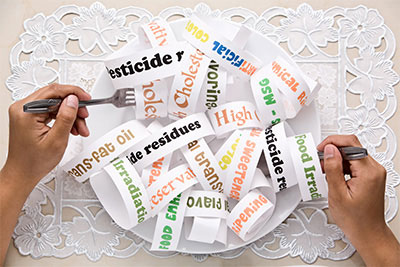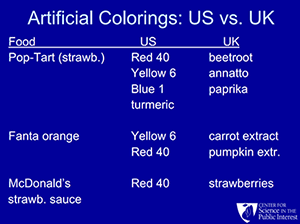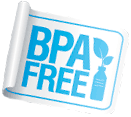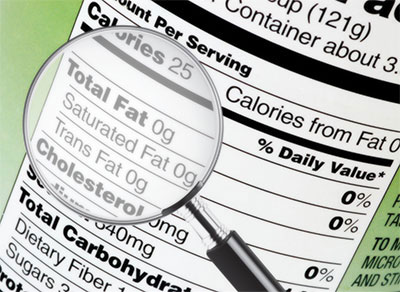Food Additives & Chemicals
 According to the World Health Organization, the contamination of our food by dangerous chemicals has become a worldwide public health concern, and is even the cause of trade problems between countries who have banned some of the chemicals allowed in the US food supply.
According to the World Health Organization, the contamination of our food by dangerous chemicals has become a worldwide public health concern, and is even the cause of trade problems between countries who have banned some of the chemicals allowed in the US food supply.
But these chemicals are not only in our food, they also get into the air we breathe, leach into our water supply, and are present in far more things than we realize:
- Food
- Pet foods and pet products
- Furniture
- Household cleaners
- Cosmetics (make-up, nail polish, etc.)
- Medications
- Supplements
- Personal care items (soaps, shampoos, conditioners, deodorants, toothpaste, mouthwash, lotions, etc.)
- Gardening products
- Plastics
The list is endless. Over time, the continual onslaught that we subject our bodies to wears down our immune system, contributing to a host of health related conditions.
The FDA: Failure to protect human & pet food...
An estimated 14,000 laboratory-made chemicals are used today in processed and refined foods alone. The types of chemicals used depend on what they are being used for. They serve to make our food look fresher, more attractive, and can make them last longer on the shelf. Some of them are stimulating and addicting, and others are carcinogenic (cancer-causing), especially in larger quantities that are eaten on a regular basis. Others act as endocrine disruptors that disrupt our hormonal balance, and yet others contribute to a wide variety of other health problems.
Any way you slice it, most of these chemicals are unnatural and not meant to be put into a healthy body.
Common categories of chemicals include:
- Buffers
- Preservatives
- Neutralizers
- Moisture content controls
- Flavorings
- Colorings
- Bleaching agents
- Maturing agents
- Psychological activity controls
- Stabilizers
- Processing aids
Why you should avoid refined foods...
In general, avoid any product that lists a chemical additive on the label (unless it clearly states that the item is derived from a natural food source). There are thousands of chemicals in packaged food, but let's take a look at some of the top offenders:
Food Colorings...
Food colorings are typically made from synthetic chemicals such as coal tar and petrochemicals that do not occur naturally in food. They are used almost exclusively in processed and refined foods such as candy, desserts, soda, canned foods, baked foods, frozen meals, and pet foods, etc. Over the years, the FDA has banned some of these coloring chemicals that have been proven as carcinogenic (substances that can cause cancer). But the use of other colorings are permitted, even though studies have shown detrimental health effects, especially in children, from very commonly used food dyes.
Artificial Colors Linked to Allergies & ADD
Artificial colors can contribute to the following reactions in children:
- Allergies
- Hyperactivity
- ADD
- Visual and learning disorders
- Nerve damage

In 2005 and 2007, the British government sponsored two studies on British children. The studies concluded that a mixture of several commonly used food dyes promoted hyperactivity, and the government instructed food manufacturers to no longer use these food dyes in food products. Instead, colors must be used from natural food sources only. From January 1st, 2013, any food product sold in the European Union that contains food dyes must show a warning label about hyperactivity.
In stark contrast, the FDA ignores these studies and claims there is "no evidence" that food coloring causes hyperactivity or learning disabilities in children. The Grocery Manufacturers Association also claims there is no need for consumers to alter their purchasing and eating habits, and that children can safely enjoy food products containing these food colors. This means that companies such as McDonald's use healthier alternatives in European countries, but are free to continue using the dangerous ones in the US. Compare the food coloring used in the US vs. UK for 3 popular items (see image).
Food Flavorings...
 Both natural and artificial flavorings are very common ingredients in our food chain. There are hundreds of chemicals created in the laboratory that are designed to mimic natural flavors in soda, canned foods, desserts, candy, and many other foods.
Both natural and artificial flavorings are very common ingredients in our food chain. There are hundreds of chemicals created in the laboratory that are designed to mimic natural flavors in soda, canned foods, desserts, candy, and many other foods. The use of flavoring often indicates that the "real food" that the flavoring is mimicking has been removed. Unfortunately, the FDA does not require food manufacturers to disclose the chemical concoction they use to create these flavorings, leaving the public to fend for itself with regard to health concerns.
The term "natural flavor" is not automatically healthier than an artificial flavor.
Artificial vs. Natural Flavoring
When we see the term "artificial flavoring" on an ingredient label, we assume it is only 1 ingredient, but it can be comprised of 50 or more different chemicals that include petroleum, paper-mill waste, or MSG. How about "natural flavoring"? Try approximately 40+ chemicals. And if the label states both "natural and artificial flavoring"… well… you do the math.
Let's take a look at strawberry flavoring:
Artificial strawberry flavoring = approx. 50 chemicals
Natural strawberry flavoring = approx. 40 chemicals (most present in artificial strawberry flavoring)
| Artificial Strawberry Flavor | ||
|
|
|
The only time a flavor is "natural" is when the ingredient label clearly states
the flavoring is derived from a natural source (e.g. paprika, carrot, or annatto).
Artificial Sweeteners...
Benzoate Preservatives (BHA, BHT, etc.)...
The World Health Organization's International Agency for Research on Cancer considers BHA a possible human carcinogen (cancer-causing). Biologically, benzoate preservatives can create the following side effects:
- Temporarily inhibit the proper functioning of digestive enzymes
- Headaches
- Stomach upsets
- Asthma attacks
- Hyperactivity in children
- Affect sleep
- Affect appetite
- Liver and kidney damage
- Hair loss
- Behavioral problems
- Cancer
- Fetal abnormalities
- Growth retardation
The National Toxicology Program classifies butylated hydroxyanisole (BHA) as “reasonably anticipated to be a human carcinogen.” It can cause skin depigmentation. In animal studies, BHA produces liver damage and causes stomach cancers such as papillomas and carcinomas and interferes with normal reproductive system development and thyroid hormone levels. It is found in food, food packaging, and personal care products sold in the U.S.
Bisphenol-A (BPA)...

This estrogen-like chemical is a man-made chemical found in countless plastic products, including plastic food containers, microwaved and frozen food containers, bottled drinks, epoxy resins, and canned foods. Research in laboratory animals has shown that a low-dose administration of BPA produces a wide spectrum of developmental and reproductive effects:(1)
- Reduced fertility & reproductive problems, including a decrease in testosterone & sperm production
- Increase in aggressive behavior
- Early onset of sexual maturation
- Changes in mammary gland development
- Cancer risk
- Metabolic disorders, such as type 2 diabetes and insulin resistance
- Heart disease
- Neurobehavioral effects, such as ADHD
A reduction in fertility has been linked to BPA contamination. Danish and American researchers discovered that women who drank 3 sodas per day were half as likely to get pregnant as women who avoided soda.
BPA is particularly risky in canned acidic foods (e.g. tomatoes) because the acidity in the food can leech even more of this toxin from the can and into the food. BPA is toxic enough for it to be banned in baby bottles in Europe, Canada, and other countries.
How to Avoid Products Containing BPA

Here are some simple tips you can follow to help you avoid BPA containers:
- Look for the BPA-free logo on plastics - if it is missing, don't buy it.
- If possible, choose pyrex-type glass containers for storage.
- Ensure most of your diet is from fresh produce, which contains no BPA.
- Choose metal or wood cooking utensils over plastic.
- Check any plastic appliances such as coffee makers to ensure they are BPA-free.
- Check baby bottles and pacifiers and use ONLY those that are BPA-free.
- Avoid pet toys with plastic components that are not BPA-free.
Sometimes the BPA-free logo can be difficult to find. On bottles, look at the bottom to see if the logo has been stamped into the plastic itself.
Monosodium Glutamate (MSG)...
MSG is an Addictive Excitotoxin
Excitotoxins affect us by reacting with specialized receptors in the brain in such a way that they lead to addiction, but also cause the destruction of certain brain cells. These highly addictive, neurotoxic substances accelerate aging and stimulate the nervous system, over time causing neurological disorders, endocrine disorders, heart attacks, strokes, tumors, vision loss, migraines, seizures, and many other diseases. They also worsen or mimic the symptoms of conditions such as fibromyalgia, MS, lupus, ADD, diabetes, Alzheimer’s disease, chronic fatigue, and depression.
Many people experience a host of other side effects including headaches, itchy skin, dizziness, and respiratory, digestive, circulatory, and coronary concerns.
Learn more about excitotoxins...
MSG is a Hidden Ingredient
Why are we not aware of MSG in our foods? Because MSG is very well hidden on ingredient lists in items such as:
- Monosodium glutamate
- Hydrolyzed vegetable protein
- Hydrolyzed protein
- Hydrolyzed plant protein
- Textured vegetable protein (TVP)
- Plant protein extract
- Sodium caseinate
- Calcium caseinate
- Yeast extract
- Autolyzed yeast
- Hydrolyzed oat flour
- Corn oil
- Soy protein isolate
Hydrogenated Oils/Trans Fats...
Because hydrogenation makes oils more stable and solid at room temperature, they are used to improve both the baking characteristics of the oil, as well as the taste and texture of the food. They are found in many processed foods, and are snuck into hundreds of "health" foods. In fact, several well-known brands of food considered very healthy and minimally processed contain hydrogenated oils. The addictive properties of hydrogenated oils have been linked to:
- Weight problems caused by a slower metabolism
- Diabetes
- Breast and colon cancer
- Heart disease and atherosclerosis
- High cholesterol
Scientists are not sure why, but hydrogenated oils increase cholesterol more so than other oils.
Avoiding Hydrogenated Oils
 Even though trans fats are recognized as a danger to our heath, they are still found in many cookies, snacks, fried foods, donuts, margarine, and baked foods. Instead of banning them, in January, 2006, the FDA mandated that food companies clearly state on the nutritional label the amount of trans fat present in the food so that consumers could choose to avoid them.
Even though trans fats are recognized as a danger to our heath, they are still found in many cookies, snacks, fried foods, donuts, margarine, and baked foods. Instead of banning them, in January, 2006, the FDA mandated that food companies clearly state on the nutritional label the amount of trans fat present in the food so that consumers could choose to avoid them.
Labeling Trick
Eating out is more challenging, as trans fats are very commonly used in restaurants and they oils they use. The best way to avoid them is to avoid foods that have been fried or pan-fried (including seafood, meats, and pastries) and watch out for salad dressings.
Pesticides in Food...
Every year, billions of pounds of pesticides become part of the American food supply. That equates to 10 pounds per person per year, which has a cumulative effect on the body. Many of these pesticides are carcinogenic (meaning they have the ability to cause cancer), and their accumulation also contributes to lowering our immune response.
Pesticides in our food
The serious diseases they can cause...
Potassium Bromate...
Banned in Other Countries
Potassium bromate is toxic enough to be banned for use in food products in the EU, Canada, Nigeria, Brazil, South Korea, Peru, Sri Lanka, and even in China. In the US, however, the FDA has not banned its use, which has become a typical response to dangerous chemicals in our food. Currently, California requires a cancer warning on the product label if potassium bromate is an ingredient.
Brominated Vegetable Oil (BVO)...
 Brominated vegetable oil increases the brightness of colors in many bottled beverages such as soda, sports drinks, and citrus flavored drinks. It is a toxic substance linked to birth defects, increasing cholesterol levels, and can cause damage to both the liver and kidneys.
Brominated vegetable oil increases the brightness of colors in many bottled beverages such as soda, sports drinks, and citrus flavored drinks. It is a toxic substance linked to birth defects, increasing cholesterol levels, and can cause damage to both the liver and kidneys. To avoid BVO, avoid artificially brightened sports drinks and sodas, and carefully check the ingredient label. Such drinks are easy to spot because the brightness looks "unnatural." Instead, reach for coconut water or fresh fruit juices (with no added sugar or chemicals!).
Banned in Other Countries
BVO is considered so toxic it has been banned in 100 countries.
Olestra (Olean)...
Rather than ban the use of olestra in food products, the FDA only requires such foods to carry a "warning" label.
Azodicarbonamide...
Sodium Nitrate & Nitrite...
While nitrate itself is harmless, sodium nitrate interacts with other substances in your stomach to form nitrosamines. This chemical reaction occurs during the frying process. Nitrosamines can produce side effects such as headaches, nausea, vomiting, and dizziness.
Perfluorooctanoic Acid (PFOA)...
PFOA has been linked to thyroid disease in humans and cancers in animals. The food industry is beginning to comply with the EPA’s 2015 goal of eradicating this chemical, however as usual, there is currently no mandate from the FDA.
RELATED ARTICLES
- Choosing natural sweeteners
- Health dangers of artificial sweeteners
- Refined sugar
- Refined sugar & chronic disease
- Soda's, pop & energy drinks
- Additives & chemicals in our food
- What are processed & refined foods
- The Dirty Dozen: What they are & why you should avoid them
- Addicted to sugary foods? Kick that addiction now
- Get off the diet merry-go-round
- Healthy food choices for children
- Healthy food choices for pets
- The FDA: Failure to protect human & pet food
- Food pyramids & food politics
View Sources & References
- (1) An extensive new literature concerning low-dose effects of bisphenol-A, Environ Health Perspect. Aug 2005; 113(8): 926-933.
- Food coloring image sourced from Centers for Science in the Public Interest
- A Consumers Dictionary of Food Additives, by author Ruth Winter
- World Health Organization (WHO)
- Food Dyes: A Rainbow of Risks, by Michael Jacobon, Ph.D.
- Finegold Association
- Science for Science in the Public Interest, Food Dyes



